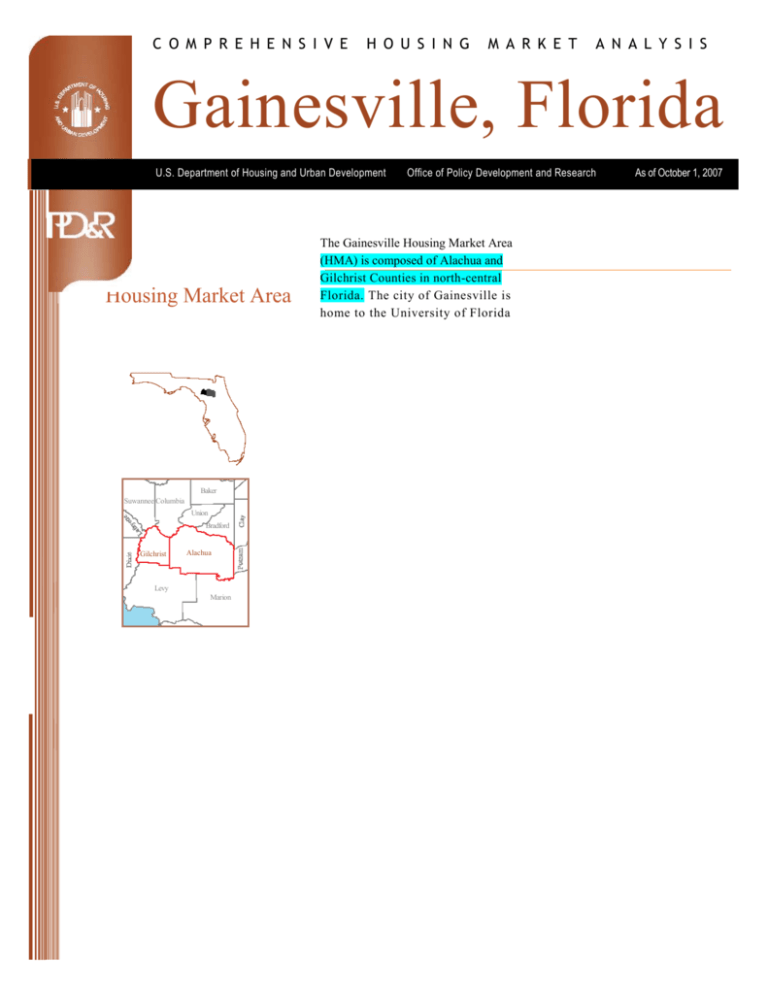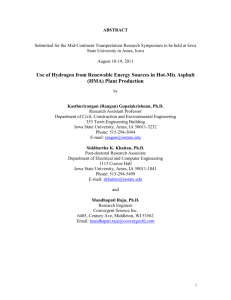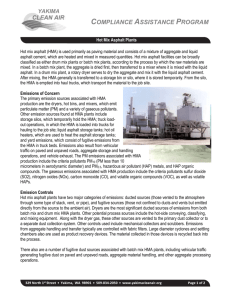COMPREHENSIVE HOUSING MARKET ANALYSIS
advertisement

C O M P R E H E N S I V E H O U S I N G M A R K E T A N A L Y S I S Gainesville, Florida U.S. Department of Housing and Urban Development Housing Market Area Baker Suwannee Columbia Union Bradford Gilchrist Alachua Levy Marion Office of Policy Development and Research The Gainesville Housing Market Area (HMA) is composed of Alachua and Gilchrist Counties in north-central Florida. The city of Gainesville is home to the University of Florida As of October 1, 2007 (UF), one of the largest universities in the nation. Recreational and cultural amenities, along with a mild climate and an expanding economy, attract new residents to the area. Market Details Economic Conditions ............... 2 Population and Households ..... 4 Housing Market Trends ........... 6 Data Profile ..................................9 Summary Economy UF is the leading employer in the Gainesville HMA. Research programs at the university in fields such as health care and biotechnology support the development of new businesses in the area. Employment in the education and health services sector has grown steadily in recent years. Job growth has also been strong in the leisure and hospitality and the professional and business services sectors. During the 12 months ending September 2007, nonfarm employment increased by nearly 2,400 jobs, or 1.8 percent, and the unemployment rate averaged 2.7 percent. Continued steady job growth is expected during the 3-year forecast period. Sales Market Single-family home sales in the HMA have declined by 18 percent in the past year, and condominium sales are down 33 percent. Median sales prices for existing single-family homes and condominiums are down 3.7 and 1.1 percent, respectively, from prices a year ago. The construction of singlefamily homes has declined by a more than one-third during the past year. Despite the slowdown in sales, the overall market is relatively balanced. The vacancy rate for sales housing is estimated at 2.1 percent. During the 3-year forecast period, demand is expected for approximately 4,400 new sales housing units in the HMA (see Table 1). Rental Market The rental housing market was soft in 2000, but has tightened in recent years, in part due to conversions of apartments to condominiums. Currently, the rental market is nearly balanced, with an estimated vacancy rate of 6.7 percent. Rents in the HMA have increased during the past 2 years because of rising property taxes and insurance premiums. Multifamily construction has been stable in recent years. During the 3-year forecast period, demand is expected for approximately 2,000 new rental units in the HMA (see Table 1). Table 1. Housing Demand in the Gainesville HMA, 3-Year Forecast, October 1, 2007 to October 1, 2010 Gainesville HMA Sales Units Total Demand 4,400 Rental Units 2,000 Under 800 300 Construction Notes: Total demand represents estimated production necessary to achieve a balanced market at the end of the forecast period. Units under construction as of October 1, 2007. Source: Estimates by analyst Economic Conditions L ocated in the city of Gainesville, U F i s o n e o f t h e n a t i o n ’ s largest state universities, with nearly 50,000 students. The university is also the leading employer in the Gainesville HMA, with more than 27,000 full- and part-time employees. Gainesville is a regional center for health care and biomedical research. Other leading employers in the area include Shands HealthCare and the Malcom Randall Veterans Affairs Medical Center, with 7,500 and 2,700 workers, respectively. Shands HealthCare is affiliated with the UF Health Science Center, the largest biomedical research organization in the state. Table 2 lists major employers in the HMA. The Gainesville area has benefited from the increase in investment in high-technology research and development in Florida. The university, along with state and local governments, has been working to develop a biotechnology industry cluster in the area, with companies spun off from UF research programs. Currently, three business incubator campuses are in the HMA, and UF is considered one of the top U.S. universities for the transfer of research technology to the marketplace. Table 2. Major Employers in the Gainesville HMA Name of Employer Employment Sector University of Florida Shands HealthCare Malcom Randall Veterans Affairs Medical Center The Oaks Mall Florida Department of Children and Families Government Health Services Government Retail Trade Government Publix Super Markets North Florida Regional Medical Center Tacachale Nationwide Mutual Insurance Company Retail Trade Health Services Health Services Financial Activities Santa Fe Community College Government Note: University of Florida employment includes full-time employees. Number of Employees 12,212 7,508 2,700 2,500 2,119 1,865 1,646 1,500 1,099 831 Gainesville’s central location on Interstate 75 (I-75), approximately halfway between Atlanta and the major population centers of South Florida, has prompted the construction of several new hotels in the area and a boost in leisure and hospitality sector employment. Transportation employment in the HMA has also increased due to the completion of several large distribution centers, including a 500,000-square-foot facility for foodservice provider SYSCO Corporation and a 1.25-millionsquare-foot Wal-Mart Stores, Inc., facility. Employment in the transportation and utilities sector has more than doubled since 2000. Figure 1 shows employment sector growth in the HMA from 1990 to the current date. Because UF and federal and state healthcare organizations are among the leading employers, the government sector accounts for more than 30 percent of nonfarm jobs in the HMA. The education and health services sector has the next largest share of jobs and accounts for nearly 17 percent of nonfarm employment. Figure 2 shows current employment by sector in the HMA. Source: Gainesville Council for Economic Outreach Recent employment growth in the HMA has been broad based. During the 12 months ending September 2007, nonfarm employment averaged about 134,400 jobs, an increase of 2,350 jobs, or 1.8 percent, from the employment level recorded a year earlier. Employment in the education and health services sector continued a steady expansion, increasing by 1.4 percent, or by about 300 jobs, compared with employment levels recorded in that sector a year earlier. During the same period, employment in the leisure and hospitality sector Economic Conditions Continued rose by 3.6 percent, or about 500 jobs, particularly in areas near I-75, and employment in the professional and business services sector increased by 3.3 percent, or about 400 jobs. The 12-month average unemployment rate remained relatively unchanged, at 2.7 percent, compared with 2.8 percent for the previous 12-month period. Figure 3 shows trends in labor force, resident employment, and the unemployment rate in the HMA from 1990 to 2006. Table 3 provides details on 12-month average employment by sector in the HMA. Figure 1. Sector Growth in the Gainesville HMA, Percentage Change, 1990 to Current Total Nonfarm Employment Goods Producing Natural Resources, Mining, & Construction Manufacturing Service Providing Trade Transportation & Utilities Information Financial Activities Professional & Business Services Education & Health Services Leisure & Hospitality Other Services Government – 10 0 10 20 30 40 50 60 70 80 90 100 110 120 130 140 150 Note: Current is based on 12-month averages through September 2007. Source: Bureau of Labor Statistics Figure 2. Current Employment in the Gainesville HMA, by Sector Natural Resources, Mining, & Construction 4.7% Manufacturing 3.5% Trade 12.6% Government 31.3% Transportation & Utilities 1.4% Information 1.4% Other Services 3.6% Financial Activities 4.9% Leisure & Hospitality 10.6% Professional & Business Services 9.4% Education & Health Services 16.7% Note: Based on 12-month averages through September 2007. Source: Bureau of Labor Statistics During the 3-year forecast period, job growth is expected to continue, particularly in the education and health services and the leisure and hospitality sectors. Nonfarm employment is expected to increase by nearly 2,900 jobs a year, or 2.1 percent. Economic Conditions Continued Figure 3. Trends in Labor Force, Resident Employment, and Unemployment Rate in the Gainesville HMA, 1990 to 2006 6.0 5.0 4.0 3.0 2.0 1.0 0.0 150,000 125,000 100,000 75,000 1990 1992 1994 Labor Force 1996 1998 2000 Resident Employment 2002 2004 2006 Unemployment Rate Source: Bureau of Labor Statistics Table 3. 12-Month Average Employment in the Gainesville HMA, by Sector Total Nonfarm Employment Goods Producing Natural Resources, Mining, & Construction Manufacturing Service Providing Trade Transportation & Utilities Information Financial Activities Professional & Business Services Education & Health Services Leisure & Hospitality Other Services Government 12 Months Ending September 2006 132,000 10,800 6,300 4,600 121,200 16,700 1,800 2,000 6,400 12,200 22,200 13,700 4,600 41,700 12 Months Percent Ending Change September 2007 134,400 1.8 11,000 1.9 6,300 0.0 4,700 2.2 123,300 1.7 16,900 1.2 1,900 5.6 1,900 – 5.0 6,600 3.1 12,600 3.3 22,500 1.4 14,200 3.6 4,800 4.3 42,000 0.7 Notes: Based on 12-month averages through September 2006 and September 2007. Numbers may not add to totals because of rounding. Source: Bureau of Labor Statistics Population and Households he presence of cultural and recreational amenities, along with a pleasant climate and expanding employment, has influenced population growth in the Gainesville HMA. T Enrollment at UF increased significantly during the 1990s, from about 35,000 students in 1990 to nearly 50,000 students in 2000. The increased enrollment accounted for roughly half of net in-migration during the decade. Although enrollment at UF has not increased since 2000, net in-migration has remained strong due to steady job growth in the HMA. Since 2000, the population has been increasing by about 3,800, or 1.6 percent, a year. As of October 1, 2007, the population of the HMA is estimated at 261,200. More than two-thirds of the population growth that has occurred since 1990 has resulted from net in-migration; net natural increase (resident births minus resident deaths) has accounted for the remainder. Net in-migration averaged about 2,900 people a year in the 1990s Population and Households Continued and about 2,800 people a year after 2000. Figure 4 shows components of population change in the HMA from 1990 to the forecast period. Because post-2000 in-migration was driven by job growth rather than university enrollment, households migrating to the area in the latter period have been somewhat larger—and there have been fewer of them. During the 1 990s, the number of households in the HMA increased by about 1,800, Figure 4. Components of Population Change in the Gainesville H MA, 1990 to Forecast 4,000 3,000 2,000 1,000 0 1990 to 2 0 0 0 2 0 0 0 to Current Net Natural Change Net Migration Figure 5. Population and Household Growth in the Gainesville H MA, 1990 to Forecast 5,000 4,000 3,000 2,000 1,000 1990 to 2000 2000 to Current Population Current to Forecast Households Sources: 1990 and 2000—1990 Census and 2000 Census; current and forecast— estimates by analyst Figure 6. Number of Households by Tenure in the Gainesville HMA, 1990 to Current 70,000 60,000 50,000 40,000 30,000 20,000 10,000 0 1990 2000 Renter During the 1990s, the number of owner households increased by about 1,100 a year, accounting for 60 percent of the total gain in households. Since 2000, the number of owner households has grown by slightly more than 1,100 a year, accounting for approximately 70 percent of household growth. Figure 6 shows the number of households by tenure in the HMA from 1990 to the current date. Current to Forecast Sources: 1990 and 2000—1990 Census and 2000 Census; current and forecast— estimates by analyst 0 or 2.2 percent, a year. After 2000, household growth slowed somewhat to about 1,600 households, or 1.7 percent, a year, despite strong in-migration. Figure 5 illustrates population and household growth in the HMA from 1990 to the forecast period. Current Owner Sources: 1990 and 2000— 1990 Census and 2000 Census; current—estimates by analyst The number of renter households increased by 700 a year during the 1990s, but growth slowed to 500 households a year after 2000. The decrease in the level of renter household growth was attributable in part to stable enrollment at UF and the construction of new dormitories offering approximately 450 rooms on campus. Another factor for the decrease was economic conditions, including low mortgage interest rates that favored homeownership. See Table DP-1 at the end of this report for additional information about population and households in the HMA from 1990 to the current date. Given anticipated continued employment growth during the 3-year forecast period, net in-migration is expected to remain strong, and the population of the HMA is expected to increase by more than 4,200 a year. The number of households in the HMA is expected to increase by approximately 1,800 a year during the forecast period. Housing Market Trends Sales Market Home sales in the Gainesville HMA have slowed in recent months, and the construction of new homes has also declined. Overall, however, the sales housing market remains balanced, with an estimated vacancy rate of 2.1 percent. Credit conditions for homebuyers have tightened in the past year and are one reason for the decline in home sales and decreases in sales prices. According to the Florida Association of REALTORS ® (FAR), during the 12 months ending September 2007, sales of existing single-family homes in the Gainesville area were down 18 percent compared with the number of existing home sales recorded during the same period a year ago, from 3,400 to 2,800 homes. During the same period, sales of existing condominiums fell by 29 percent, from 1,400 to 1,000 units. According to FAR, the median price for existing single-family homes sold during the third quarter of 2007 was $207,300, down nearly 4 percent from $215,200 a year earlier. During this same 12-month period, median prices for existing condominiums fell by 1 percent, from $156,300 to $154,600. In response to the slowdown in home sales, builders have scaled back Figure 7. Single-Family Building Permits Issued in the Gainesville HMA, 1990 to 2007 1,600 housing construction in the HMA, as measured by the number of building permits issued. For the 12 months ending September 2007, the number of single-family homes authorized by building permits declined by one-third compared with the number recorded during the same period a year ago, from 1,200 to 800 homes. Figure 7 provides details about single-family building permits issued in the HMA from 1990 to 2007. About one-fourth of multifamily units built in the HMA since 2000 have been condominiums, including several complexes located near the university. Many of these developments consist of high-end units, which appeal to residents who want to live near the campus stadium and other urban amenities. One such example is University Corners, a mixed-used residential and retail complex to be located adjacent to the UF campus. As of September 2007, approximately 2,100 homes were for sale in the HMA, according to the NATIONAL ASSOCIATION OF REALTORS ®. At the current pace of sales, the unsold inventory represents a supply of less than 3 months. Despite the slowdown in home sales, the sales housing market is relatively balanced. The current sales vacancy rate of 2.1 percent is just slightly above the 2-percent vacancy rate recorded in 2000. 1,400 1,200 1,000 800 600 400 200 0 Notes: Includes only single-family units. Includes data through September 2007. Source: U.S. Census Bureau, Building Permits Survey Anticipated household growth during the 3-year forecast period will result in a demand for 4,400 new sales units. A portion of the expected demand will be met by the 800 units currently under construction. Table 4 shows estimated demand by price range for new market-rate sales housing in the HMA during the forecast period. Housing Market Trends Sales Market Continued Table 4. Estimated Demand for New Market-Rate Sales Housing in the Gainesville HMA, October 1, 2007 to October 1, 2010 Price Range ($) From To 100,000 149,999 150,000 199,999 200,000 249,999 250,000 299,999 300,000 349,999 350,000 399,999 400,000 449,999 450,000 499,999 500,000 549,999 550,000 599,999 600,000 649,999 650,000 and higher Units of Demand 420 660 830 690 500 350 300 220 130 90 60 150 Percent of Total 9.5 15.0 18.9 15.7 11.4 8.0 6.8 5.0 3.0 2.0 1.4 3.4 Source: Estimates by analyst Rental Market Multifamily construction in the HMA was strong in the late 1990s. By 2000, the rental market was soft, with a vacancy rate of 7.9 percent. Conditions have tightened in recent years, partly as a result of the conversion of some existing rental units to condominiums. Currently, the rental housing market is balanced, with an estimated vacancy rate of 6.7 percent. Figure 8 illustrates rental vacancy rates in the HMA from 1990 to the current date. The current average monthly rent in the HMA is about $750 for a twoFigure 8. Rental Vacancy Rates in the Gainesville HMA, 1990 to Current 12.0 11.0 10.4 10.0 9.0 8.0 7.9 7.0 6.7 6.0 5.0 4.0 3.0 2.0 1.0 0.0 1990 2000 Sources: 1990 and 2000—1990 Census and 2000 Census; current—estimates by Current analyst bedroom apartment. During the past 2 years, average rents have risen by nearly 4 percent a year due to rising property insurance premiums, taxes, and other operating costs. Students represent the largest group of renters in the HMA. About 80 percent of UF students live off campus; approximately half of those students live in three- or four-bedroom units with separate leases for individual occupants. The average monthly rent for off-campus housing is about $550. From 2004 to 2006, approximately 20 apartment complexes, or 3,000 apartments, were converted to condominiums in the HMA. Many of these units were bought by investors and have remained in the rental inventory. The impact on the student-driven rental market was limited because most of the converted apartments were one- or two-bedroom units instead of the larger apartments frequently rented by students. Although the level of multifamily construction in the HMA peaked in the late 1 990s, construction Housing Market Trends Rental Market Continued activity, as measured by the number o f b u ild i n g p er mi t s i ss u ed , ha s remained relatively strong since 2000. Multifamily construction averaged fewer than 500 units permitted a year during the early 1990s but increased to more than 1,000 units a year in the late 1990s. Since 2000, the number of units permitted has averaged Figure 9. Multifamily Building Permits Issued in the Gainesville HMA, 1990 to 2007 1,800 1,600 1,400 1,200 1,000 800 600 400 200 0 Notes: Includes all multifamily units in structures with two or more units. Includes data through September 2007. Source: U.S. Census Bureau, Building Permits Survey about 900 units a year. During the 12 months ending September 2007, building permits were issued for approximately 800 multifamily units, essentially unchanged from the number of units permitted during the previous 12 months. Figure 9 provides details about multifamily building permits issued in the HMA from 1990 to 2007. During the 3-year forecast period, student enrollment at UF is expected to remain stable and growth in the number of renter households will be driven primarily by employment and population increases. Demand is expected for 2,000 new rental units, part of which will be met by the 300 units currently under construction. Table 5 shows estimated demand by rent level for new market-rate rental housing in the HMA during the forecast period. Table 5. Estimated Demand for New Market-Rate Rental Housing in the Gainesville HMA, October 1, 2007 to October 1, 2010 1 Bedroom Monthly Gross Rent ($) 600 650 700 750 800 850 900 1,000 1,100 1,200 1,300 and higher 2 Bedrooms Units of Demand 880 775 710 640 560 475 400 320 260 200 160 Monthly Gross Rent ($) 800 850 900 950 1,000 1,050 1,100 1,200 1,300 1,400 1,500 and higher 3 or More Bedrooms Units of Demand 870 720 660 590 510 440 370 300 190 130 90 Monthly Gross Rent ($) 1,100 1,150 1,200 1,250 1,300 1,350 1,400 1,500 1,600 1,700 1,800 Units of Demand 250 230 200 180 150 130 110 80 60 40 30 and higher Notes: Distribution above is noncumulative. Demand shown at any rent represents demand at that level and higher. Source: Estimates by analyst Da ta Pr of il e Table DP-1. Gainesville HMA Data Profile, 1990 to Current 1990 2000 Current Average Annual Change (%) 1990 to 2000 2000 to Current Total Resident Employment Unemployment Rate (%) 94,303 3.8 118,900 3.0 130,300 2.7 2.3 1.2 Nonfarm Employment 97,100 123,300 134,400 2.4 1.2 Total Population 191,263 232,392 261,200 2.0 1.6 Total Households 74,542 92,530 104,700 2.2 1.7 Owner Households 41,331 52,416 60,800 2.4 2.0 Percent Owner (%) 55.4 56.6 58.1 Renter Households 33,211 40,114 43,900 1.9 1.2 2.0 1.8 4.0 2.4 Percent Renter (%) 44.6 43.4 41.9 Total Housing Units 83,093 101,019 115,100 Owner Vacancy Rate (%) 3.0 2.0 2.1 Rental Vacancy Rate (%) 10.4 7.9 6.7 $31,402 $46,587 $54,854 Median Family Income Note: Median family incomes are for 1989, 1999, and 2006. Sources: Estimates by analyst; U.S. Census Bureau; U.S. Department of Housing and Urban Development 10 Data Definitions and Sources 1990: 4/1/1990—U.S. Decennial Census 2000: 4/1/2000—U.S. Decennial Census Current date: 10/1/2007—Analyst’s estimates Forecast period: 10/1/2007–10/1/2010— Analyst’s estimates Demand: The demand estimates in the analysis are not a forecast of building activity. They are the estimates of the total housing production needed to achieve a balanced market at the end of the 3-year forecast period given conditions on the as-of date of the analysis, growth, losses, and excess vacancies. The estimates do not account for units currently under construction or units in the development pipeline. For additional data pertaining to the housing market for this HMA, go to www.huduser.org/ publications/pdf/CMARtables_GainesvilleFL. pdf. Contact Information James Conner, Field Economist Jacksonville HUD Field Office 904–232–1777, ext. 2112 james.h.conner@hud.gov This analysis has been prepared for the assistance and guidance of the U.S. Department of Housing and Urban Development (HUD) in its operations. The factual information, findings, and conclusions may also be useful to builders, mortgagees, and others concerned with local housing market conditions and trends. The analysis does not purport to make determinations regarding the acceptability of any mortgage insurance proposals that may be under consideration by the Department. The factual framework for this analysis follows the guidelines and methods developed by HUD’s Economic and Market Analysis Division. The analysis and findings are as thorough and current as possible based on information available on the as-of date from local and national sources. As such, findings or conclusions may be modified by subsequent developments. HUD expresses its appreciation to those industry sources and state and local government officials who provided data and information on local economic and housing market conditions. For additional reports on other market areas, please go to www.huduser.org/publications/econdev/mkt_analysis.html.






